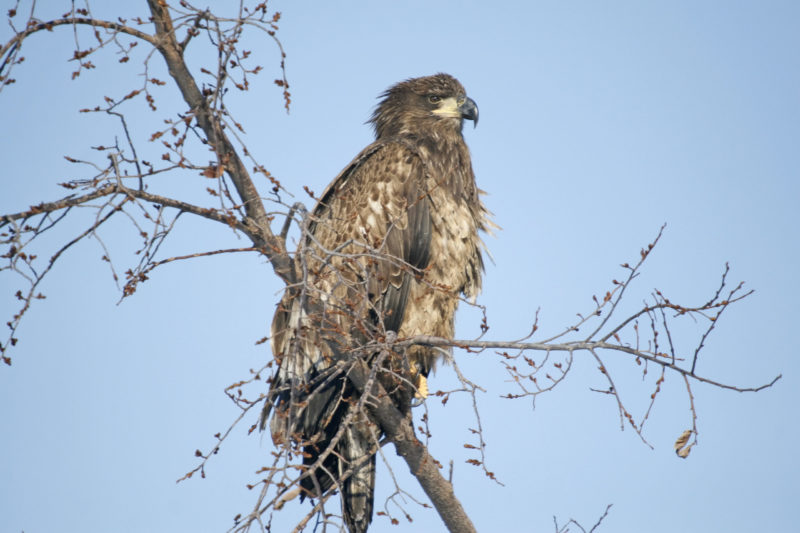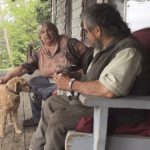The Canadian Shield lakes of the Northern Wilds region are often rich in aquatic species, but seeing terrestrial wildlife, because of the dense forests, is a more difficult matter. But where the two meet—the water/forest edge—visitors can expect to see critters, especially birds that are associated with water.
And the best way to see these birds is by canoe, simply because they are virtually silent (unless you have a talkative partner or someone who bangs their paddle on the canoe with every stroke!), and they force you to travel slowly.
Let’s learn about what birds are commonly seen, and one that you’ll need to keep your eyes (or ears) alert to find.
Bald Eagle
The American bald eagle is distinct with its white head and tail, large wingspan, and yellow beak, although these traits are completely attained in its fourth year. Juveniles are brown, with a dark beak, and gradually attain bits of white each year. As is the case with all birds of prey, females are larger than males.
Most pairs form life long bonds. They often arrive back on territory in April to fix up the nest (which is usually a third of the way down a large tree, frequently a pine). Females lay two or three eggs and both adults share incubation duties and care of the young. Juveniles must be fed and do not leave the nest until they are full grown and able to fly. This type of bird development is known as “altricial.”
Bald eagles both catch and scavenge fish. They also feed on muskrats, ducks and loons. For such a large bird, they have a weak, plaintive whistling cry. Watch for them near the windward shore, since they’ll be watching for windblown fish or other carrion to be washed up along the beach.
Osprey
A third smaller than the bald eagle, and exclusively a piscivore (fish-eater), ospreys are masters of hovering over a fish before diving talons-down. They’ve been known to dive to a depth of three feet. Its white head is split at the eye with a dark brown brand. Belly is white. The rest is brown. Sexes are also identical.
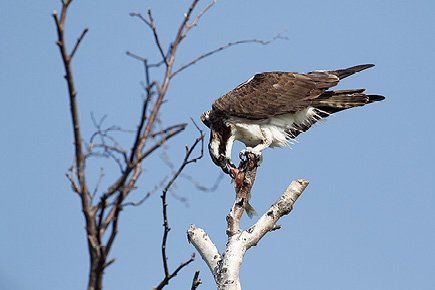
Osprey return north later than the bald eagles because they must depend upon fish, while the eagle can scavenge or hunt mammals until the lakes and rivers open up. Nests are usually at the very top of a tree, often on a broken off snag. One to four eggs will be laid, which the female will incubate while the male hunts for her. Both hunt for the altricial young which will remain nest bound until fully grown.
Soaring overhead, they can be told from eagle’s broad, roundish-tipped, and straight wings by its narrow, pointed, wings that form a shallow “M” when seen from beneath. Since osprey and bald eagles compete for food, you’ll usually not find them nesting anywhere near each other.
Common Loon
Like the osprey, the common loon is entirely dependent upon fish or other aquatic critters, but “hunt” underwater rather than from the sky.
Bigger than a mallard, but smaller than a Canada goose, the common loon is largely black with white flecks on its back and wings, with a white neck and belly. Its dark head is actually an iridescent green or blue, depending upon the angle and quality of sunlight. The bill is pointed, with ridges inside to help grasp wiggling fish. Other birds have hollow bones for easier flight, but loons have solid bones for ease of diving underwater. They propel themselves with their large flippered feet, not their wings, and can stay under for five minutes and dive to a depth of 250 feet. They are able to compress their feathers to squeeze out trapped air, as well as forcing air from their lungs to ride low in water or sink slowly out of sight.
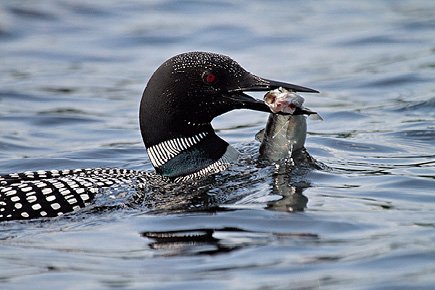
the sky. | MICHAEL FURTMAN
With legs set so far back for diving, loons can barely walk, and only go ashore to mate and nest, and then, only at the very edge of the water. Typically, only one or two eggs are laid. Both adults incubate and feed the young, which leave the nest shortly after hatching.
Loons are very vocal, especially during the mating season. Their tremolo call sounds like a laugh and is believed to signal alarm. The yodel, a long, rising call with repetitive notes, which can last up to six seconds, is given only by the male to defend territory. The wail is perhaps the most haunting of the loon’s calls; it is used most often during social interactions with other loons. The hoot is a one-note call that is used by family members to maintain contact with each other.
Belted Kingfisher
Bigger than a robin, smaller than a crow, belted kingfishers are more often heard than seen. Inconspicuous as they perch on branches along shore, they are noisy, frequently making their high, harsh chittering call.
Bluish-gray backs as well as on their shaggy crested heads, their underside and neck are white. Females and juveniles have a rusty band across the chest and under the wings. Both sexes have a dark, V shaped breast band.
Like the osprey, kingfishers often hover over their prey before plunging. At other times, they’ll dive directly from a perch. Unlike the osprey that catches prey with talons, kingfishers use their long, stout bill to grab prey, usually minnows or frogs.
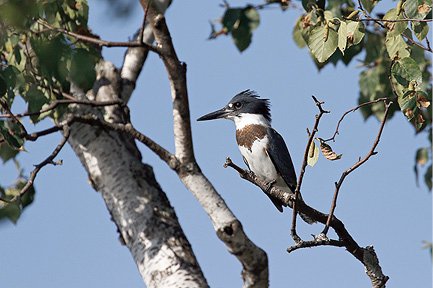
than seen. | MICHAEL FURTMAN
Amazingly, they nest underground, digging a burrow in dirt banks. Broods of three to five are common. Both parents feed them while they are still in the nest, but once flying, they are taught to fish by the adults. Kingfishers choose a new mate each nesting season.
Common Merganser
This mallard-sized duck fishes underwater much like a loon (to which they are not related), but at shallower depths and for smaller prey. Females and non-breeding males are largely grey, have a rust-colored head and shaggy crest, and a long, serrated orange bill adapted for grasping minnows. Breeding males share this same bill but are largely white with a dark head that can appear either green or black, depending upon the light.
Despite its large size, the common merganser often nests in tree cavities excavated by pileated woodpeckers. When cavities are unavailable, they’ll nest on the ground. Up to a dozen eggs are laid by the hen, who does all the incubating and care of the young. Males depart as soon as incubation begins.
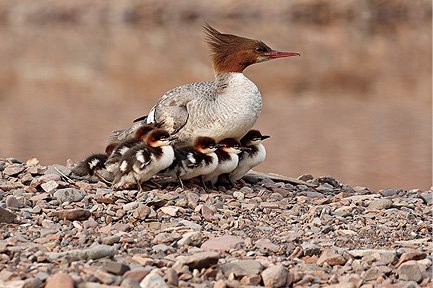
Ducklings leave the nest as soon as they hatch, but in the company of the hen. Unlike the helpless altricial young of other birds, ducklings are “precocial” meaning they are mobile and feed themselves. They are able to dive under water within hours. Sometimes hens share “day care” duties by combining broods, forming what is called a “creche.” Sometimes as many as 20 or 30 ducklings might be found trailing a single hen. They’re not all hers!
Other Ducks
You might see black ducks, as we are on the western edge of their range. Unlike most duck species in which hens and drakes look different from each other, black duck sexes are virtually identical. If near enough, you can tell a hen from a drake by the bill. The hen will have dark mottled spots on it, while the drake will be a solid yellow. Both look like a very darkly colored mallard hen in plumage, and in fact are closely related to mallards.
Common goldeneyes, a large diving duck, also nest in our region, although they aren’t often seen due to their secretive nature. They also nest in tree cavities. The most common diving duck is the ring-necked duck. Drakes are similar in color to scaup (bluebills) but show far less white and have a white ring on their dark bill. This species prefers to nest on the floating bog that surrounds so many of our lakes.
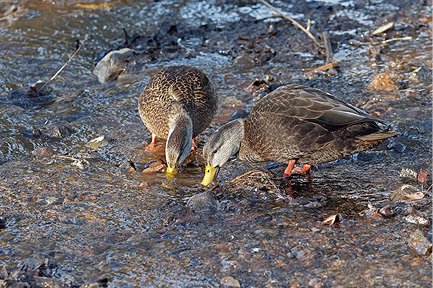
By late June, or certainly mid-July, the young of all of most of these species will begin to be visible, whether peaking from their nest, or trailing an adult on the water. A morning’s paddle along a quiet shore is bound to turn up one or more of these wilderness water birds. Grab your binoculars and camera, and get out on the water.


